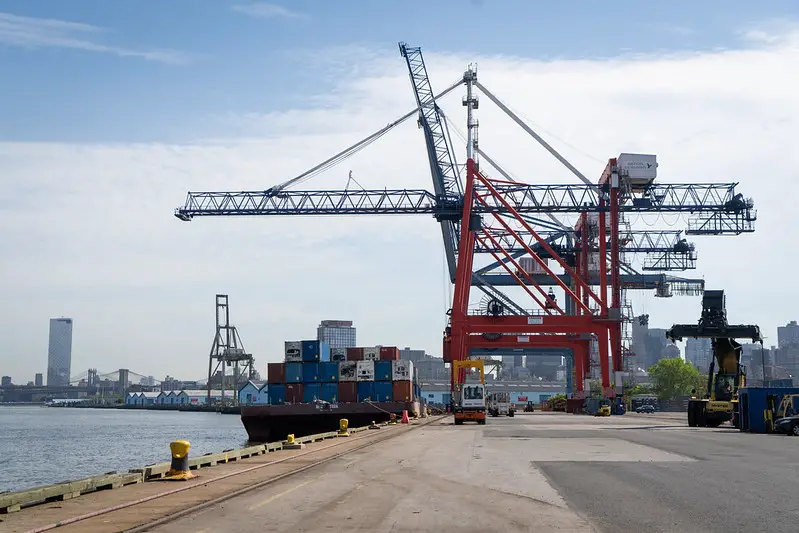
The 122-acre Brooklyn Marine Terminal (BMT) is one of the city’s last remaining maritime industrial sites on the waterfront. It’s also the last place that should be rezoned for market-rate housing. The New York City Economic Development Corp.’s (EDC) claims their redevelopment proposal for BMT ensures the growth of our maritime industry. Nothing could be further from the truth.
EDC is a quasi-governmental authority that assumed oversight of our waterfront in 1991. Since then, much of our working waterfront has been converted to housing in Williamsburg, Greenpoint, and Long Island City or public open space such as Hudson River or Brooklyn Bridge Parks. EDC has little commercial maritime experience and should not be the steward of our maritime industrial waterfront, as their track record shows.
EDC assumed operation of the Manhattan Cruise Terminal in 1998 and have left half of the piers empty and deteriorating for the past decade. Pier 92 remains derelict, and Pier 94 is being converted into movie studios (not maritime). In 2004, they promised Red Hook residents hundreds of jobs that never materialized at the Brooklyn Cruise Terminal which is rarely used.
EDC established NYC Ferry in 2016 charging $2.75 for all riders with unlimited transfers. Tourists flocked to the new service that cannibalized the city’s maritime sightseeing industry. NYC Ferry ran practically empty during the pandemic and a 2022 city comptroller’s audit found that almost $250 million of the $753 million EDC spent to roll out NYC Ferry was unaccounted for. It found the stated per trip public subsidy of $6.60 was in fact $12.38.
Moving packages on our waterways was first proposed in 1994. EDC embraced the concept and rebranded it the “blue highway” in 2023. The first site they selected for package delivery was the Downtown Heliport in Manhattan, insisting that package delivery was compatible with an operating heliport. It made no sense to experienced maritime operators and EDC withdrew the request.
Last June, EDC signed a 99-year lease for BMT, accepting the property “as is,” with $500 million in deferred maintenance. They claim BMT needs a $1 billion investment to reconfigure the existing piers and double the number of containers received at BMT, insisting that BMT’s redevelopment must be funded with revenue generated on the site.
EDC is proposing more than 9,000 units of market-rate housing be built on half of BMT to “save” the other half for maritime industry. Their plans include a new truck route through the market-rate housing to distribute products. Delivery trucks are choking our roadways and residents, deteriorating our bridges and highways, and competing with pedestrians and bicycles on our streets.
BMT’s existing piers could be restored for $600 million and logistic centers, temperature-controlled warehouses, and vehicle maintenance facilities built where EDC proposes housing. Packages and produce can be stored, sorted, and repackaged on site.
Arriving goods can then be loaded onto electric vehicles and placed on smaller ferries at adjacent Piers 9a and 9b for transport to delivery locations like Pier 92 at W. 52nd St. in Manhattan. Trucks should only leave BMT to deliver packages to adjacent neighborhoods.
Pier 8 should become a much-needed vessel repair, repower, and refueling facility supporting commercial and emergency services vessels operating in the Harbor and the “blue highway” fleet, strengthening our maritime industry, resiliency and emergency preparedness. The current situation at BMT is unique because the adjacent communities want maritime industry on their waterfront.
EDC should use Industrial Development Agency tax incentives and bonds for new construction and operations as they did at the $843 million South Brooklyn Marine Terminal to support the offshore wind industry. BMT is in the same Industrial Business Zone and eligible for this public support. Providing long-term leases would allow future maritime industrial operators and logistics companies to invest private capital to match public incentives.
Creating a viable public/private partnership is essential to develop a hub for the “blue highway.” BMT is on the same Red Hook waterfront where Amazon, FedEx and UPS have planned, or recently built, last-mile delivery warehouses. Those warehouses could be served by this “blue highway” hub removing thousands more trucks from our city streets and supporting New York’s growth in the 21st century
The maritime community, Red Hook residents and all New Yorkers deserve the protection of this valuable maritime industrial infrastructure that’s critical to our city’s economy, environment, emergency preparedness, and sustainability.
Fox was co-founder and CEO of New York Water Taxi, is a board member of the City Club of New York, and author of “Creating the Hudson River Park: Environmental and Community Activism, Politics, and Greed.”

